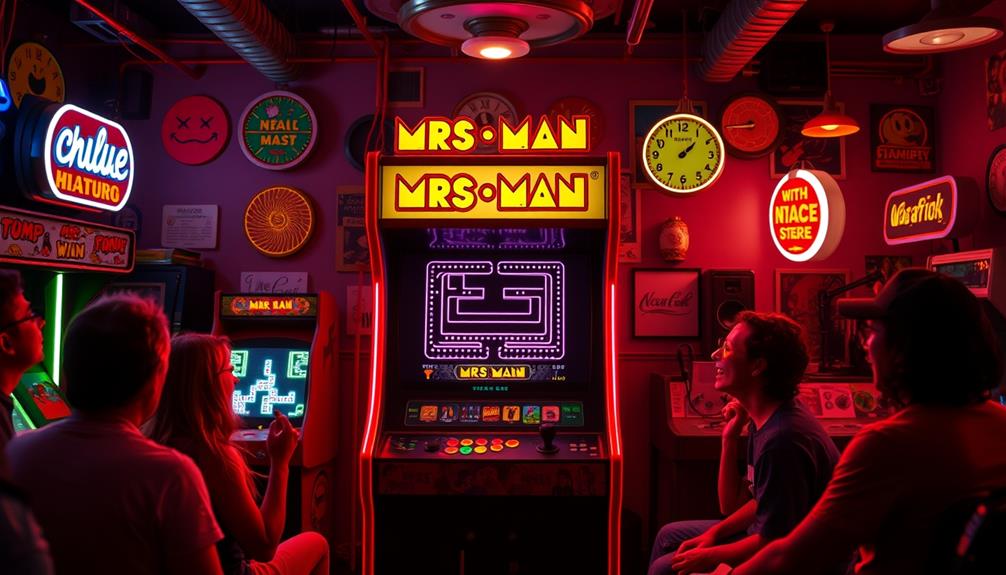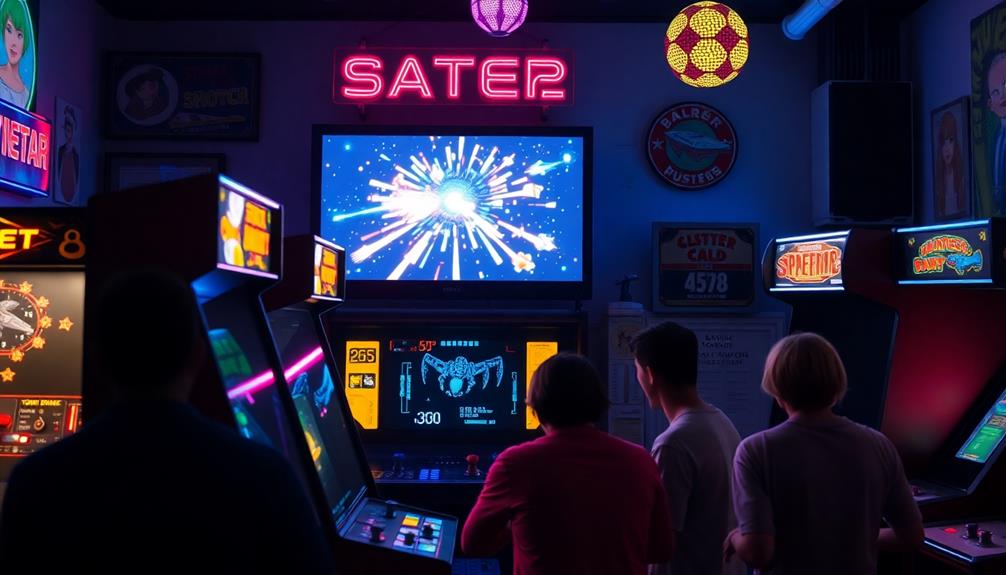The Donkey Kong kill screen and level 22 crash happen because of technical limits in the game’s hardware and software. At level 22, a programming flaw causes memory overflow, leading the game to freeze or crash. These glitches highlight how early game systems could fail unexpectedly, creating legendary moments for players. Curious about the detailed causes and how players have challenged or avoided these glitches? Keep exploring to uncover more.
Key Takeaways
- The kill screen and level 22 crash result from hardware limitations and memory overflow issues in the arcade version of Donkey Kong.
- These phenomena cause game freezes, corrupted graphics, and unresponsive controls at specific points, especially after level 22.
- The crash occurs due to a programming flaw where counters overflow, leading to data corruption and game breakdown.
- Players and speedrunners exploit or bypass these glitches using emulator patches or hardware modifications.
- The kill screen has become a cultural symbol representing the limits of early arcade game technology and mastery.
The Origins of the Donkey Kong Kill Screen
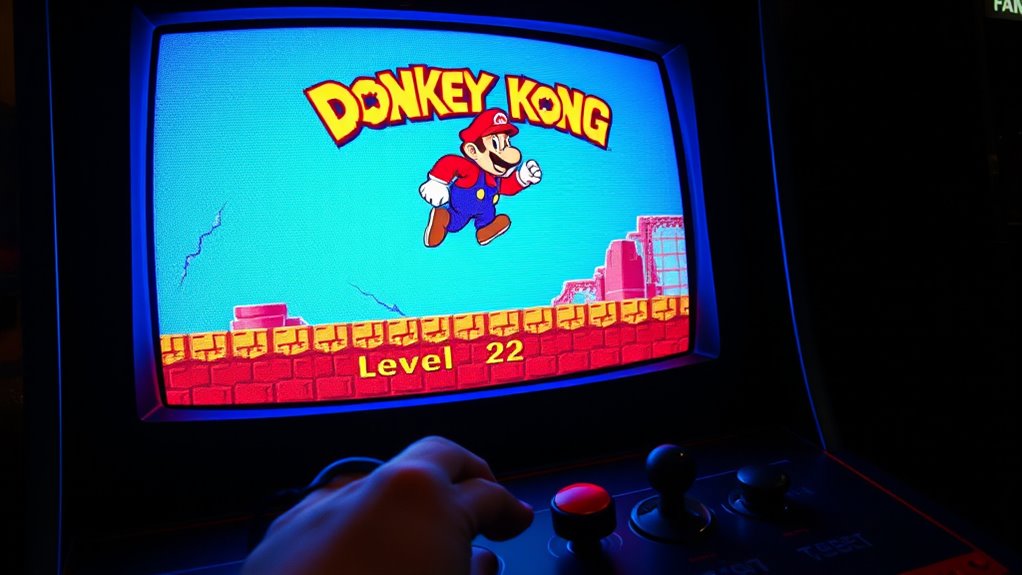
The Donkey Kong kill screen originates from a programming flaw that occurs when players reach level 22, causing the game to crash unexpectedly. This flaw is tied to the arcade hardware and how it handles game data. As you progress through gameplay mechanics, the game relies on specific memory addresses to track levels and character positions. When you hit level 22, the game’s code encounters a bug that makes it attempt to access an invalid memory location. Due to the limitations of the arcade hardware, this results in a crash rather than a graceful exit. This flaw isn’t just a simple glitch; it’s rooted in the way the hardware and game code interact, making the kill screen a unique and infamous part of Donkey Kong’s history. Memory management plays a crucial role in understanding why this crash occurs and how hardware limitations contribute to the phenomenon.
How the Kill Screen Shows Up in Gameplay
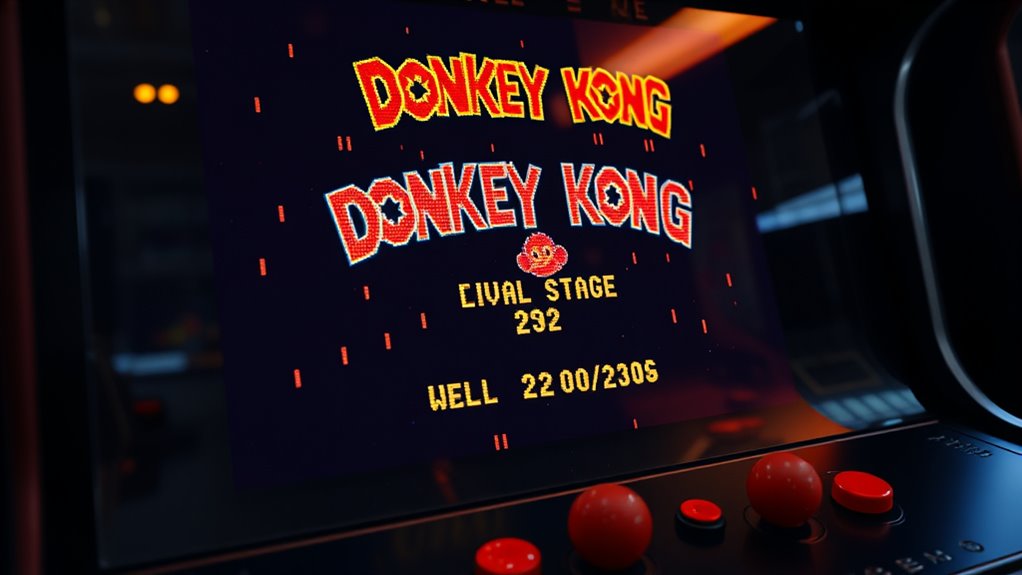
As you approach level 22 in Donkey Kong, the gameplay suddenly changes in an unmistakable way. The familiar mechanics give way to a static, unresponsive screen, signaling the kill screen’s appearance. This glitch is rooted in game design limitations, where the hardware can’t process the level data correctly. You’ll notice that Mario and Donkey Kong stop moving, and the game becomes unplayable. Detecting this glitch relies on recognizing these visual cues early. To help you understand, here’s a quick overview:
| Aspect | What You See | Effect |
|---|---|---|
| Mario’s movement | Freezes or stops suddenly | Gameplay halt |
| Screen display | Unchanging or corrupted graphics | Visual cue for glitch detection |
| Enemy behavior | Stops or acts erratically | Confirms glitch presence |
| Level progression | No further progress | Game is stuck |
| Player control | No response | Indicates kill screen |
This shows how game design limitations lead to the kill screen’s appearance during gameplay. Additionally, understanding game programming constraints helps explain why such glitches occur.
The Technical Cause Behind the Kill Screen
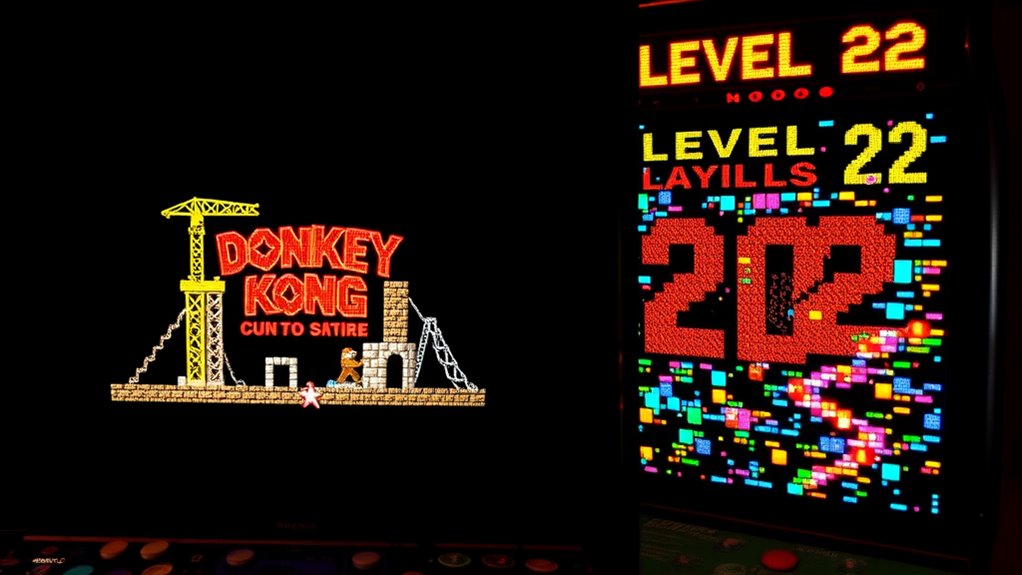
The kill screen in Donkey Kong results from a technical glitch caused by the game’s hardware limitations, specifically in how it processes data related to level 22. The arcade hardware, particularly the memory and processing capacity, couldn’t handle the game’s data structures beyond this point. During level 22, the game’s design relies on a counter that exceeds the maximum value the hardware can handle, causing an overflow. This overflow corrupts the game’s internal variables, leading to the crash or freeze. The glitch is rooted in the way game design interacts with hardware constraints, highlighting how limitations in arcade hardware can inadvertently create unexpected game-breaking moments. Fundamentally, the kill screen is a direct consequence of the hardware’s inability to correctly process data at higher levels. Additionally, understanding these limitations helps illustrate the importance of data-driven strategies in designing resilient software systems.
Famous Players and Their Encounters With the Kill Screen

Many legendary players have their own stories of hitting the kill screen for the first time, often leading to unforgettable moments. Some experienced surprise and frustration, while others found creative ways to navigate or avoid the crash. Exploring their strategies and key encounters reveals how players have learned to challenge the game’s limits. Additionally, understanding the game mechanics involved in the Donkey Kong kill screen can provide deeper insight into why these moments occur at level 22.
Classic Players’ First Encounters
Famous players often remember their first encounter with the Donkey Kong kill screen as a defining moment in arcade gaming. It’s a rite of passage that combines arcade nostalgia with the thrill of pixel artistry. You might recall the intense focus, the blinking screens, and the moment when the game suddenly crashes at level 22. Many players felt a mix of frustration and awe, realizing they had reached a rare, almost mythical point in the game. Their stories often highlight:
- The adrenaline rush of hitting the kill screen unexpectedly
- The awe inspired by the game’s pixel-perfect design
- The feeling of achievement in reaching the impossible
- The shared camaraderie among players who experienced it first-hand
- The game’s technical limitations that caused the crash, adding to its legendary status
These moments became legendary, shaping memories of classic arcades forever.
Notable Kill Screen Moments
Some of the most memorable moments in arcade history come from legendary players who have faced the Donkey Kong kill screen firsthand. These moments highlight how arcade hardware and game design can unexpectedly halt a game’s progress, creating a legendary milestone. For example, Steve Wiebe’s attempt at a high score brought widespread attention to the kill screen phenomenon. His encounter revealed how the game’s hardware limitations and design flaws lead to the level 22 crash, effectively ending his run. These moments became iconic because they showcase the unpredictable nature of arcade gaming and how even skilled players can be halted by the game’s architecture. Such encounters turn into stories that inspire gamers and underscore the complex relationship between game design and hardware limitations. The kill screen itself exemplifies how technical constraints can impact gameplay, making these moments a fascinating aspect of arcade history.
Strategies to Avoid Crash
While avoiding the infamous Donkey Kong kill screen can seem nearly impossible due to its hardware-based nature, skilled players have developed strategies to prolong their gameplay and reduce the likelihood of a crash. You can improve your chances with specific controller techniques and multiplayer strategies. For example, mastering precise jump timing minimizes risk during critical moments. Using tailored controller inputs can help prevent unintended movements that trigger the crash. Playing with a partner allows for shared responsibilities, reducing stress and mistakes. Additionally, practicing level navigation helps anticipate tricky sections, avoiding unnecessary risks. Focus on consistent, deliberate moves, and consider customizing your controller settings for better control. Incorporating precise timing can help mitigate errors that lead to game crashes. These approaches don’t eliminate the crash but give you a better shot at reaching higher levels without encountering the kill screen.
The Mythology and Cultural Impact of the Kill Screen
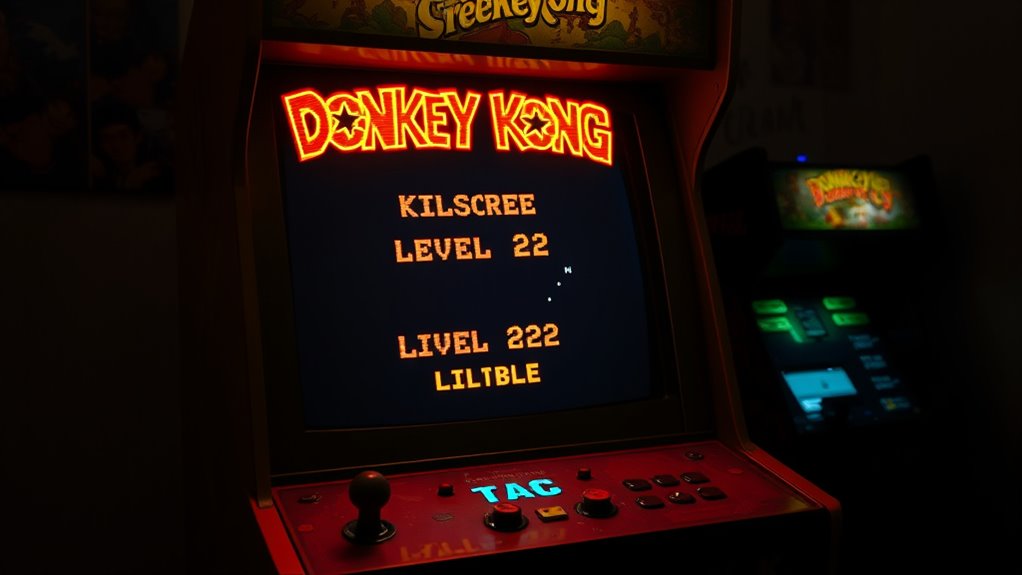
The kill screen has evolved beyond a mere technical glitch into a symbol of gaming’s limits and mysteries. Its mythology symbolism fuels stories of players pushing boundaries and confronting the game’s inherent constraints. This phenomenon embodies the idea that even in digital worlds, there are ultimate boundaries that challenge mastery and persistence. Over time, it has become a cultural touchstone, inspiring legends and debates about game design and human endurance. The kill screen’s mystique encourages players to see gaming as more than entertainment—it becomes a metaphor for confronting the unknown and accepting failure as part of growth. As a cultural icon, it prompts reflection on the fragility of perfection and the allure of the unreachable, cementing its place in gaming history and collective consciousness. The integration of advanced technology into gaming systems has made encountering such phenomena more predictable, yet it also deepens the sense of mystery surrounding these boundaries.
Exploring the Mysterious Level 22 Crash

Among the many mysteries surrounding the kill screen, Level 22’s infamous crash stands out as one of the most perplexing. You might wonder how arcade hardware and game design collide to cause such a phenomenon. This crash occurs because of a specific flaw in the original Donkey Kong code, related to how the game handles memory and counters. As you reach level 22, the game’s internal logic breaks down, leading to unpredictable behavior. Key factors include:
Level 22’s crash stems from memory overflow and flawed code, causing unpredictable arcade behavior at this legendary milestone.
- Limitations in arcade hardware processing power
- Unintended interactions in game design mechanics
- Overflow in memory addressing
- The precise point where code fails to reset correctly
- The complexity of hardware limitations that contribute to such crashes
Understanding these elements reveals how hardware constraints and game design intricacies create this mysterious crash, making Level 22 a legendary milestone in arcade history.
Technical Explanations for the Level 22 Error
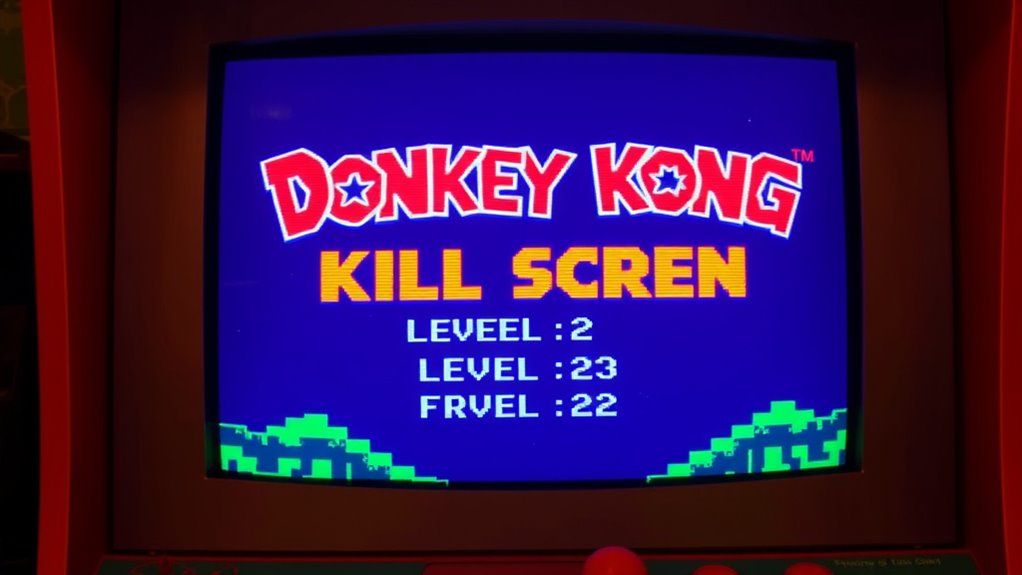
The Level 22 crash often results from a memory address overflow that confuses the game’s code. This overflow triggers a software bug, causing unexpected behavior or crashes. Understanding these technical issues helps explain why the error occurs at this specific point. Memory management techniques are crucial in preventing such errors in game programming.
Memory Address Overflow
Have you ever wondered what causes the infamous Level 22 crash in Donkey Kong? It’s often linked to memory address overflow, where the game’s limited hardware manages data improperly. Because of hardware limitations, the game uses a finite memory space to store variables and game states. When the game reaches a certain point, this space can overflow, causing memory corruption that disrupts normal operation. This overflow leads to unpredictable behavior, such as the crash at level 22.
- Limited memory capacity of arcade hardware
- Incorrect handling of memory pointers
- Overflow in level or score counters
- Data corruption due to overflow risks
Understanding how memory address overflow occurs helps explain why the game crashes, revealing the importance of hardware constraints in classic arcade failures.
Software Bug Trigger
A software bug often triggers the Level 22 crash in Donkey Kong by exploiting flaws in the game’s code logic. This occurs when specific in-game actions, combined with precise timing, cause the game’s programming techniques to misfire. For example, the game’s design relies on certain memory states and counters that, if manipulated, lead to unexpected behavior. When players reach Level 22, a particular bug in the way the game handles sprite movement or score calculation causes an overflow or invalid memory access. These bugs stem from oversights in game design and programming techniques, where edge cases weren’t fully accounted for. As a result, the game’s internal logic breaks down, leading to the infamous crash or kill screen.
Differences Between the Kill Screen and Level 22 Crash
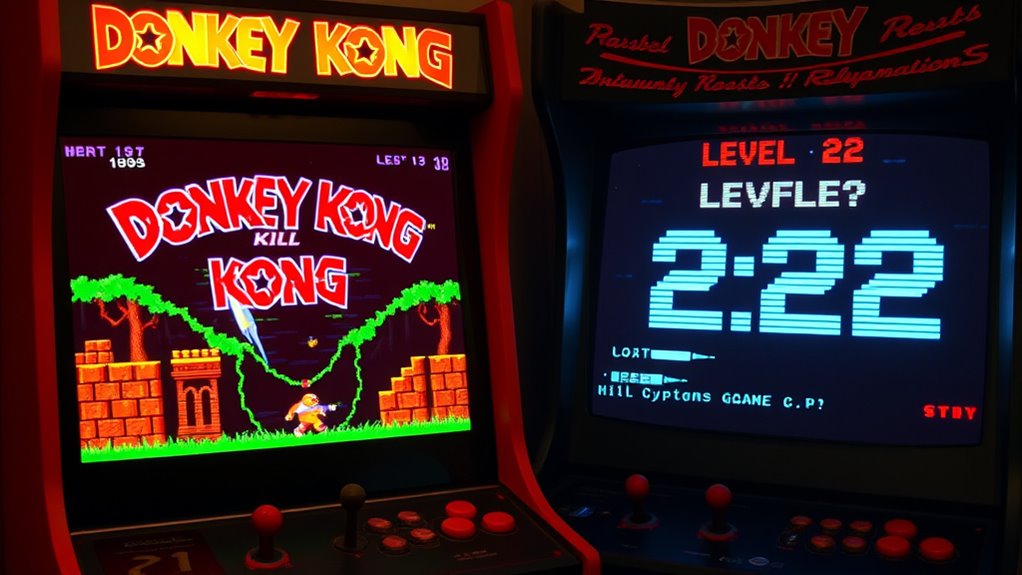
Understanding the differences between the Donkey Kong kill screen and the Level 22 crash reveals distinct gameplay anomalies. The kill screen occurs due to arcade hardware limitations and programmer errors during high-score calculations, causing the game to freeze. In contrast, the Level 22 crash stems from a specific bug in the game’s code, leading to a sudden game reset or crash. The kill screen is a fixed, unavoidable endpoint, while the Level 22 crash can sometimes be triggered intentionally. These glitches highlight how arcade hardware and programming flaws create unique gameplay anomalies. Recognizing these differences helps you appreciate the technical intricacies behind these legendary gaming moments.
- The kill screen results from hardware limits, especially CRT display resolution.
- The crash at Level 22 involves a software bug, often due to memory mismanagement.
- Kill screens are predictable, occurring at a specific point in gameplay.
- Level 22 crashes can be intentionally triggered through specific actions or glitches.
Attempts to Overcome or Bypass These Glitches

Players have developed various methods to bypass or mitigate these glitches, such as using emulator patches and updates. Speedrunners exploit glitch tricks to skip problematic levels or reduce the risk of crashing. Hardware modifications also offer alternative ways to stabilize gameplay and avoid the kill screen or crash conditions.
Emulator Patches and Updates
Emulator patches and updates have become essential tools for addressing the notorious glitches like the Donkey Kong kill screen and Level 22 crash. By refining hardware emulation, developers can simulate arcade preservation efforts more accurately, reducing the impact of these bugs. These updates help bypass glitches without altering the original gameplay experience, allowing players to enjoy authentic runs. Patches often target specific ROM versions or hardware behaviors, ensuring compatibility across various platforms. They also improve stability and prevent crashes caused by imperfect emulation. As a result, enthusiasts and researchers preserve arcade history more effectively, keeping classic titles accessible. Understanding these updates highlights how technology helps maintain the legacy of iconic arcade games despite inherent hardware limitations.
- Fixes for specific glitch triggers
- Enhanced accuracy in hardware emulation
- Compatibility improvements for emulators
- Preservation of authentic gameplay experiences
Speedruns and Glitch Exploits
Speedrunners have developed innovative strategies to bypass or exploit glitches like the Donkey Kong kill screen and Level 22 crash, pushing the boundaries of what’s possible within the game’s constraints. They use precise speedrun tactics to trigger or avoid these glitches, often timing their moves with incredible accuracy. Glitch detection plays a crucial role, as runners observe subtle cues to determine when a glitch may activate or be bypassed. Some exploit glitches intentionally, manipulating game states to skip difficult sections or prevent crashes. Others focus on avoiding triggers that cause the kill screen or crash altogether. These tactics require deep game knowledge, quick reflexes, and meticulous planning, allowing runners to extend their runs and challenge existing records while steering through the game’s unpredictable glitch landscape.
Hardware Modifications
To overcome or bypass the notorious donkey kong kill screen and level 22 crash, enthusiasts have turned to hardware modifications that alter the console’s internal circuitry. These hardware retro upgrades allow you to bypass the limitations of the original design, ensuring smoother gameplay and access to later levels. Using modification techniques such as soldering, adding jumpers, or installing custom chips, you can prevent the game from hitting the glitch points. These techniques effectively rewire or reprogram the console’s hardware to avoid the kill screen or crash. Some enthusiasts even design custom circuit boards to streamline the process. By investing in hardware mods, you gain more control over gameplay, preserving the challenge while avoiding the disruptive glitches that halt progress. This approach offers a more permanent solution compared to software tricks or exploits.
Legacy and Lessons From Early Video Game Glitches
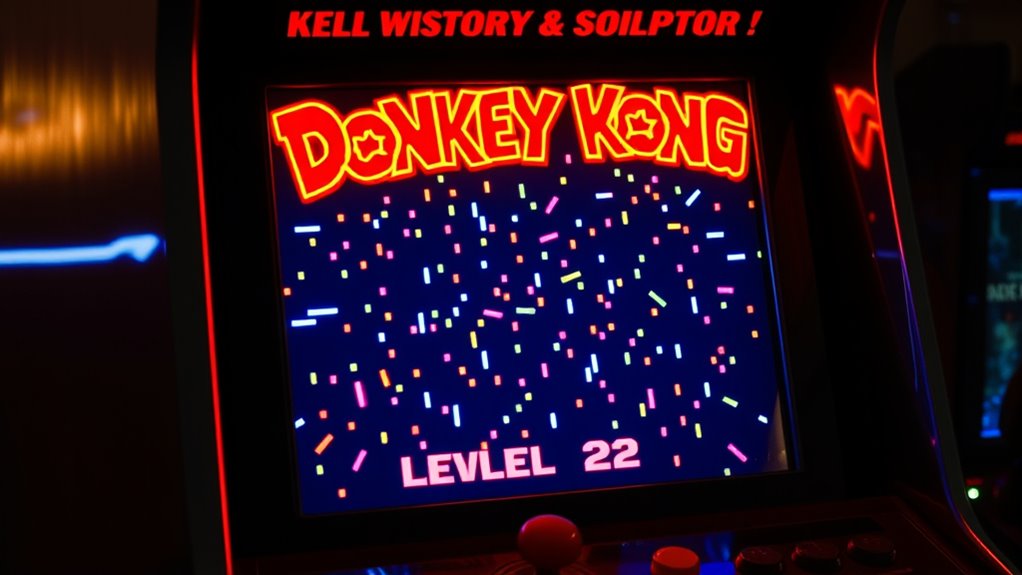
Early video game glitches like the Donkey Kong kill screen and the level 22 crash have left a lasting legacy by revealing the fragility of game design and the importance of thorough testing. These glitches show how complex systems can unexpectedly break down, emphasizing that even pixel art graphics can hide underlying vulnerabilities. As players, you learn that game design isn’t just about visuals; it’s about creating resilient experiences. Developers have since prioritized debugging and testing, understanding that small oversights can lead to significant issues. These early glitches also inspired the development of speedrunning communities, turning flaws into challenges. Ultimately, they teach that mistakes in code can shape future innovations, encouraging designers to build more robust, enjoyable games that stand the test of time.
Frequently Asked Questions
Are There Any Known Ways to Prevent the Kill Screen From Appearing?
You wonder if you can prevent the kill screen. While hardware limitations cause these issues, some programming workarounds can delay or avoid them. For example, adjusting game settings or using specific techniques can help manage memory use or timing, reducing the likelihood of crashes. However, fully preventing them isn’t always possible due to inherent hardware constraints, but clever programming can extend gameplay and minimize their impact.
How Do Modern Games Handle or Prevent Similar Glitches Today?
Think of modern games as vigilant guardians, constantly scanning the horizon for glitches lurking in the shadows. They handle or prevent issues through game patching, which acts like a shield, fixing vulnerabilities before players encounter them. Developers also employ glitch detection systems that catch anomalies early, ensuring smooth gameplay. By staying one step ahead, they keep the gaming experience seamless, turning potential chaos into a well-orchestrated symphony.
Has Nintendo Officially Acknowledged the Existence of the Kill Screen and Level 22 Crash?
You wonder if Nintendo has officially acknowledged the kill screen and Level 22 crash. Nintendo acknowledgment of these glitches is limited; they haven’t made formal statements about them. Developer commentary from the original creators indicates awareness of these issues, but Nintendo’s focus has been on gameplay experience rather than addressing these specific glitches. So, while they recognize the phenomena informally, there’s no official endorsement or detailed explanation from Nintendo.
Are There Recorded Instances of Players Successfully Fixing the Crash During Gameplay?
You ask if players have successfully fixed the crash during gameplay. While there are no widely recognized player workarounds or official crash recovery methods, some enthusiasts have experimented with techniques like resetting the game or adjusting hardware. However, these are not guaranteed solutions. Most players simply restart the game, hoping to avoid the crash, but no reliable fix has been documented for consistent crash recovery during gameplay.
What Other Classic Arcade Games Are Known for Similar End-Level Glitches?
Imagine stumbling upon a hidden secret in classic arcade games—you’re not alone. Many arcade glitches and game exploits like the infamous Pac-Man tunnel wrap-around or the Galaga double-firing bug are well-known for causing unexpected end-level issues. These glitches often result from programming quirks, creating unintended consequences. Exploring these quirks adds excitement, revealing how players can sometimes leverage arcade glitches to their advantage, turning glitches into part of the challenge.
Conclusion
As you explore the world of Donkey Kong glitches, you realize these moments are more than just technical quirks—they’re whispers of gaming history’s delicate balance. The kill screen and level 22 crash remind you that even in digital worlds, there’s a humbling beauty in limits. Embracing these rare encounters lets you appreciate the artistry behind the game, inspiring respect for the craft and curiosity to uncover what lies beyond the known.

